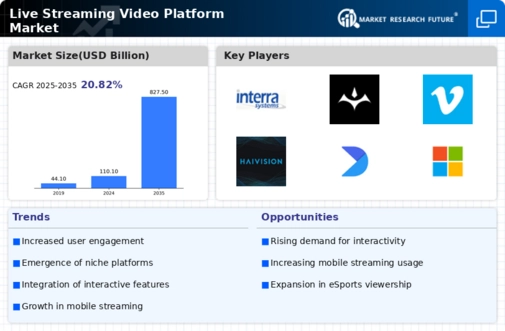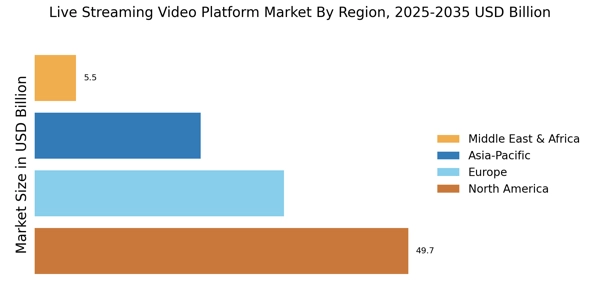Technological Advancements
Technological advancements play a crucial role in shaping the Live Streaming Video Platform Market. Innovations in streaming technology, such as improved bandwidth capabilities and enhanced video compression algorithms, have made it easier for users to access high-quality live content. The proliferation of 5G technology is particularly noteworthy, as it enables faster and more reliable streaming experiences. Recent statistics suggest that platforms utilizing advanced technologies have seen user engagement rates increase by approximately 25%. Furthermore, the integration of artificial intelligence and machine learning into streaming platforms enhances user experience through personalized content recommendations. As these technologies continue to evolve, they are likely to drive further growth in the Live Streaming Video Platform Market, attracting both content creators and viewers alike.
Rising Demand for Live Events
The Live Streaming Video Platform Market experiences a notable surge in demand for live events, including concerts, sports, and conferences. This trend is driven by the increasing preference for real-time engagement among audiences. According to recent data, the number of live streaming events has increased by over 30% in the past year, indicating a robust appetite for live content. As more organizations and creators recognize the potential of live streaming to reach wider audiences, the market is likely to expand further. This demand is not only limited to entertainment but also extends to educational and corporate sectors, where live streaming serves as a vital tool for engagement and communication. Consequently, the Live Streaming Video Platform Market is poised for significant growth as it adapts to meet the evolving needs of consumers.
Increased Focus on User Engagement
User engagement remains a pivotal focus within the Live Streaming Video Platform Market. Platforms are increasingly incorporating interactive features such as live chats, polls, and Q&A sessions to foster a sense of community among viewers. This emphasis on engagement is supported by data showing that interactive live streams can boost viewer retention rates by up to 50% compared to traditional video formats. As audiences seek more immersive experiences, platforms that prioritize user interaction are likely to gain a competitive edge. Additionally, brands and marketers are recognizing the value of engaging with consumers in real-time, leading to innovative marketing strategies that leverage live streaming. This trend is expected to further enhance the appeal of the Live Streaming Video Platform Market, driving growth and innovation.
Shift Towards Subscription-Based Models
The Live Streaming Video Platform Market is witnessing a significant shift towards subscription-based models, which offer consumers access to exclusive content and ad-free experiences. This trend is largely driven by the desire for premium content and the willingness of users to pay for enhanced viewing experiences. Recent data indicates that subscription revenues in the live streaming sector have increased by over 40% in the last year, reflecting a growing acceptance of this model among consumers. Platforms that adopt subscription services are likely to benefit from increased customer loyalty and recurring revenue streams. This shift not only enhances the financial stability of streaming platforms but also encourages the production of high-quality content, further enriching the Live Streaming Video Platform Market.
Expansion of E-Sports and Gaming Content
The expansion of e-sports and gaming content significantly influences the Live Streaming Video Platform Market. With millions of viewers tuning in to watch competitive gaming events, platforms that cater to this demographic are experiencing unprecedented growth. Recent statistics reveal that e-sports viewership has surged, with some events attracting over 10 million concurrent viewers. This trend not only highlights the popularity of gaming but also underscores the potential for monetization through sponsorships and advertising. As more gamers and content creators enter the live streaming space, the market is likely to see an influx of diverse content offerings. This expansion of e-sports and gaming content is expected to drive further investment and innovation within the Live Streaming Video Platform Market, creating new opportunities for both creators and platforms.

















Leave a Comment